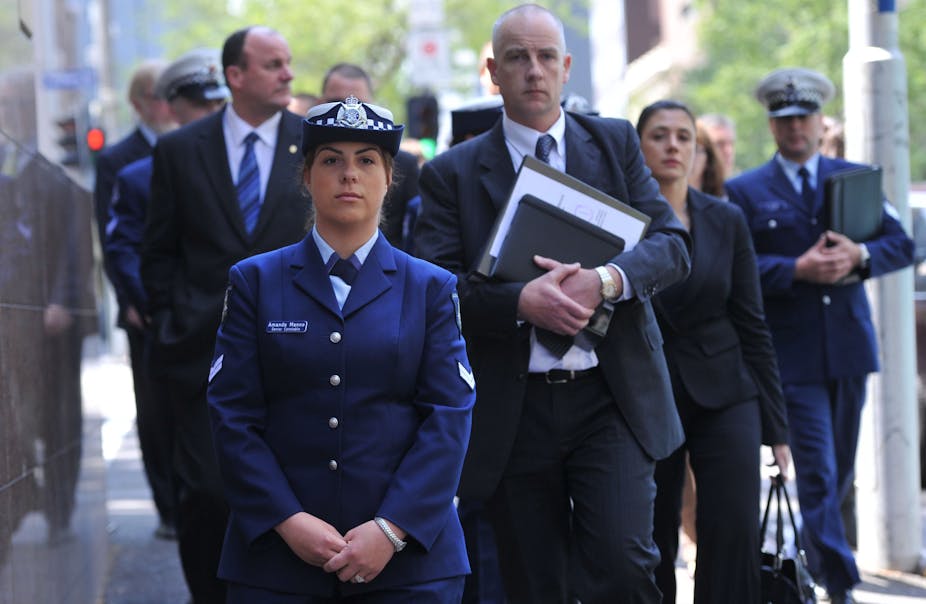This week two men were shot by members of Victoria Police. One on the street in St Kilda, the other in a Centrelink office in Windsor. The first was killed, the second seriously injured.
Police media spokespersons immediately reported to the media that the officers had no choice and that they supported the actions of their members. The following day the Chief Commissioner confirmed this support.
The same response occurred the night that 15 year old Tyler Cassidy was shot at ten times by police in park outside Northlands shopping centre. He was hit six times.
Police officers have a very difficult task. They do not go out intending to shoot citizens on the street.
When such an event occurs they need all the support they can get from senior supervising officers. They may well need to be reassured in private that it appears they had no choice.
But the judgement of this matter should be left in the hands of State Coroner to decide, not senior police officers immediately after the event, or Police Command with all the support of the police media unit.
The matter should be independently investigated, and if a death has occurred, this involves the homicide squad, the Police Integrity Unit and the State Coroner.
I have closely followed the policy with respect to police use of firearms in such street confrontations for over twenty years.
In more recent times the issue arose as a controversial one in the early 1990s. Between January and May in 1994, there were seven deaths as a result of the use of firearms by members of Victoria Police.
Over a period of 20 years from 1986, there were more than 40 deaths. How could this be explained, given that in New South Wales there had been only a fraction of this number of deaths resulting from police shootings over the same period of time?
During the late 1980s and early 1990s, whenever an operational member of the police was confronted with a citizen threatening them with any sort of weapon, be it a gun, a knife, baseball bat or whatever, it was the formal practice to extend a warning to the person to drop the weapon.
If the peson failed to drop the weapon and continued to present a potential threat to the officer, it was standard practice to shoot several times to the central body of person posing the treat, in order to remove that threat.
In effect this was a practice of shoot to kill, although the terms has always been avoided by Victoria Police. This training practice had been implemented officially by the Police Training Academy.
The general public did not have a lot of sympathy with the interests of persons committing serious crimes like armed robbery or assault.
But over the years the growing number of citizens shot dead by Victoria Police were those without a criminal record, but rather burdened with serious mental illness.
After the shooting death of a young indigenous woman, Colleen Richman at Hanover welfare services in St Kilda in September 1994, the policy of police use of firearms was changed by force command.
Project Beacon retrained all members of Victoria Police in alternative conflict resolution methods, which placed the protection of human life as the number one priority: the priority of the police officers concerned, the general public and the person attracting police attention. The number of deaths diminished dramatically over the following fifteen years.
But the pendulum slowly swung back again, and repeatedly in recent years police officers have resorted to use of firearms when they could have taken alternative courses of action.
Tyler Cassidy was shot six times, in an incident that took a total of less than two minutes. Project Beacon recommended a stand off approach, a securing of the area, calling for resources and negotiation and communication.
It appears all too obvious to the general public that there must be alternatives to the use of firearms in such cases. The rate of such deaths at particular periods in recent history make this so obvious.
That is why I believe that police media representatives and Police Command should not make public judgement of such events until the inquiries have been completed and all the facts are presented to the State Coroner. Otherwise, the thinking public will realise they are having the wool pulled over their eyes.
Support the officers involved for sure, broaden the training of such young officers to deal with the challenging circumstances they now face on the street, but keep the protection of human life as the number one priority for those whose task it is to uphold the law.

